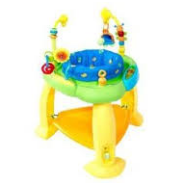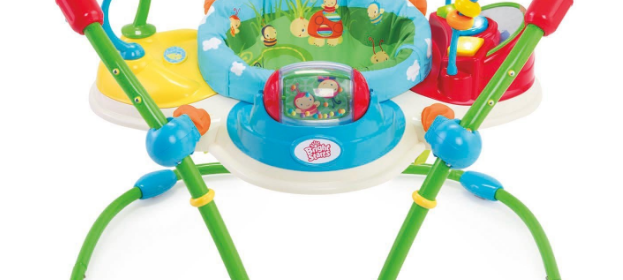Related Post
As your baby is growing, it’s important to have the right toys to help with their development through the coming months. With the help of activity jumpers, babies can establish a strong foundation for bone and muscle growth as well as boosting their fine motor skills. This list has the top-rated activity jumpers for babies that will keep them engaged and entertained.
Types
Fisher-Price Jumperoo
 Fisher-Price is one of the best companies to rely on when it comes to buying toys for your little one. Their Jumperoo collection gives babies the comfort and security they need to sit and play. The overhead canopy with hanging toys is phenomenal for encouraging the development of spatial sense and motor skills meanwhile making playtime more fun than ever before. It is incredibly stimulating with activities located all around the jumper. Once playtime is over, parents can easily pack up the unit and store it away.
Fisher-Price is one of the best companies to rely on when it comes to buying toys for your little one. Their Jumperoo collection gives babies the comfort and security they need to sit and play. The overhead canopy with hanging toys is phenomenal for encouraging the development of spatial sense and motor skills meanwhile making playtime more fun than ever before. It is incredibly stimulating with activities located all around the jumper. Once playtime is over, parents can easily pack up the unit and store it away.
Evenflo ExerSaucer
With the combination of learning, playing, and jumping, your baby will have the time of their life when they’re using the Evenflo ExerSaucer. With a 360-degree rotating bodice, babies can play with all of the interactive activities all around the jumper. They will be able to build their core strength and develop key muscles needed to promote healthy walking. With an integrated height adjustment feature, you can continue to use the unit for all ages, and it offers 2x more bounce than other jumpers on the market. Parents can also remove the toys from the unit to customize the playing experience.
Baby Einstein Musical Motion Activity Jumper
Third on the list of top-rated activity jumpers for babies is this Baby Einstein model. It offers an incredible amount of features that are not only useful for parents, but children as well. There are over 12 activities that your baby can enjoy including a light up piano that offers three different playing modes. The comfort features include a high back seat and top of the line padding for the utmost amount of comfort. The 360-degree rotating seat is essential for reaching all of the toys around the entirety of the unit so babies can have unrestricted access. With the machine washable seat, you can easily take the unit apart and sanitize it for safe play. Also, there are five different height settings, which make the unit useful throughout the most crucial years of your baby’s development.
Sassy Inspire The Senses Bounce Center
 The Sassy Inspire The Senses Bounce Center doesn’t offer as many features as the above three jumpers, but it is a cost effective and convenient solution for parents. This model offers three different height adjustment settings that can create a customized fit for your baby. The removable seat pad is great for regular cleaning and it also rotates 360 degrees, so your baby will have a full range of motion. With a mirrored spinner, play station, and wonder wheel, there are an ample amount of activities to keep your baby entertained. Also, parents can change the toys on the jumper to create new and exciting play experiences every day.
The Sassy Inspire The Senses Bounce Center doesn’t offer as many features as the above three jumpers, but it is a cost effective and convenient solution for parents. This model offers three different height adjustment settings that can create a customized fit for your baby. The removable seat pad is great for regular cleaning and it also rotates 360 degrees, so your baby will have a full range of motion. With a mirrored spinner, play station, and wonder wheel, there are an ample amount of activities to keep your baby entertained. Also, parents can change the toys on the jumper to create new and exciting play experiences every day.
If you’re a vape enthusiast or just curious about what’s hot in the vaping scene, you’ve come to the right place. As we dive into the second half of 2023, the vaping industry continues to evolve and surprise us with innovative trends, including smoother thc vape oil.
2023 is setting an exciting era for both seasoned vapers and newcomers alike as they embrace these hottest trends in the world of electronic cigarettes. There is no shortage of exciting developments for vapers to explore. In this blog post, we’ll dive into the hottest vaping trends that have been making headline news in 2023.
Smaller Devices With More Powerful Features

In 2023, the trend has shifted from big chunky devices to smaller and more compact devices with incredibly powerful features packed into their sleek designs. These pocket-sized powerhouses offer vapers the convenience of portability without compromising on performance. With advancements in technology, manufacturers have managed to shrink down the size while enhancing the overall experience.
With this advance comes its notable feature: impressive battery life. Despite their diminutive stature, they boast longer-lasting batteries that can keep you vaping all day long. No more worrying about your device dying on you at an inconvenient time. Additionally, these compact devices often come equipped with adjustable wattage or temperature settings, allowing users to customize their vaping experience according to personal preferences.
Nicotine Salts
 These innovative e-liquids offer vapers a smoother nicotine hit compared to traditional freebase nicotine liquids. But what exactly are nicotine salts? Nic salts are a form of nicotine naturally present in tobacco leaves. They undergo a process known as salt formation, where they combine with an organic acid to create a more stable compound. This results in a milder throat hit while still delivering high nicotine levels.
These innovative e-liquids offer vapers a smoother nicotine hit compared to traditional freebase nicotine liquids. But what exactly are nicotine salts? Nic salts are a form of nicotine naturally present in tobacco leaves. They undergo a process known as salt formation, where they combine with an organic acid to create a more stable compound. This results in a milder throat hit while still delivering high nicotine levels.
Using nicotine salts means you can vape at higher concentrations without causing harshness or discomfort. This makes them particularly appealing to heavy smokers looking for a more satisfying alternative. These salts also offer a faster absorption rate into the bloodstream, providing vapers with instant satisfaction and helping curb cravings more effectively.
Customizable Vape Juice
Now this is what freedom looks like in the vaping world. Vape enthusiasts are now able to set up their own unique flavors and tailor their vaping experience to suit their preferences. With a wide range of options available, vapers can mix and match different unique flavors and nicotine strengths and even add extra ingredients like menthol or sweeteners.
Whether you prefer fruity blends, creamy desserts, or refreshing menthols, there are endless possibilities for creating your perfect vape. Not only does customizing your vape juice allow you to personalize your flavor profile, but it also gives you more control over your nicotine intake.
Vaping Devices With App Integration

With an app-integrated device, you can easily adjust settings such as temperature, wattage, and airflow right from your smartphone. No more fumbling around with buttons or menus on a tiny screen – simply swipe and tap to customize your vape to perfection.
But it doesn’t stop there. These apps also offer additional features like tracking your nicotine intake, monitoring battery life, and even finding nearby vape shops or fellow vapers who share your preferences. It’s like having a personal vaping assistant at your fingertips.
Buying a gift is usually considered as thoughtful. However, it can also be an overwhelming process to some. There are a variety of reasons why one would want to purchase a gift. While traveling in Switzerland, one may want to buy gifts for friends and family as a comeback home gift or just to show appreciation. In the search of the gift, how does one get the perfect gift? Below are some factors to consider.
Get The Perfect Gifts While In Switzerland
Budget
It is important to consider the amount of money that one is willing to spend. Gifts will range in prices and size. According to Geschenkideen by Geschenkhexe having a budget will help one stay within the limits of what they want to spend. Remember it is not about the cost of the gift but the thought behind giving the gift that counts.
Consider the people
Write down a list of the people you plan to buy gifts for. Consider their age, their gender, their hobbies or career, and needs. This will help you buy a practical gift that they will appreciate. Different gifts will be purchased for different ages and genders. For instance, for a child, if they have been asking for a football, one can buy a Swiss toy shop and get a ball that has a Switzerland flag. If you have a friend who loves cooking and trying out new recipes, one can buy a Swiss recipe cookbook.
One can also consider past events or upcoming events and occasions as a guide to getting a gift. This can be a recent graduation, a promotion that happened or an upcoming birthday or a special day. For instance, for one who recently graduated one can get a good photo frame from a trinket shop for the person to place their graduating photo.
Places to shop
 There are many places one can buy from. It all depends on the type of gift one would want to purchase. One can visit the local shopping malls and store and pick and item. One can also go to the local bookshops to look for books. If one plans on buying toys, they can visit toy children toy stores within the area. If it is candy and chocolate, there are candy store available for one to visit. There are also a variety tourist stores available in Switzerland for one to buy keepsakes, souvenirs, and trinkets to give to family and friends. Another avenue one can use, is visit online stores and purchase an item.
There are many places one can buy from. It all depends on the type of gift one would want to purchase. One can visit the local shopping malls and store and pick and item. One can also go to the local bookshops to look for books. If one plans on buying toys, they can visit toy children toy stores within the area. If it is candy and chocolate, there are candy store available for one to visit. There are also a variety tourist stores available in Switzerland for one to buy keepsakes, souvenirs, and trinkets to give to family and friends. Another avenue one can use, is visit online stores and purchase an item.





